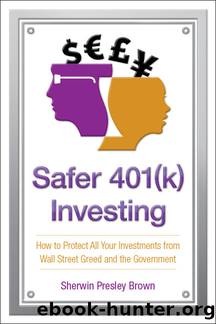Safer 401(k) Investing by Sherwin Presley Brown

Author:Sherwin Presley Brown
Language: eng
Format: epub
Publisher: Beaver's Pond Press
Published: 2012-11-19T00:00:00+00:00
Chapter 9
When the Blood on Wall Street
Flows into Your Street
So youâve decided to stick in the market and weather the storm. But now youâre not quite sure in which direction to go; hedge funds are a gamble and tend to be Ponzi schemes; bonds are technically safer but have a slow rate of return and also have risk, and that risk outweighs the reward in my opinion. With so many companies in economic trouble, itâs hard to pick a stock that is safe and has a high propensity to pay a return on investment (ROI).
When managing a portfolio, I insist on diversity and keeping 30 percent in cash at all times. Napoleon Bonaparte always kept one third of his army in reserve to react to any unforeseen situations. This is the same policy I hold regarding a portfolio; keeping 30 percent in cash gives the client flexibility to react to dips and opportunities in the market.
Hint: Warren Buffett always buys low and sells high. He invests when everyone else is too scared to invest. Read between the lines and youâll find that he never commits 100 percent of his cash no matter how good the deal isâhe always has cash on hand, in good times and in bad.
At least 30 percent of your monthly contribution to your investment portfolio should go to a cash-type investment; preferably it would be FDIC insured.
As the old saying goes, âBuy when there is blood in the street.â You should be buying when everyone is selling, and selling when everyone is happily buying. People invest wildly out of greed and get out of the market at a loss because of fear. Remember the 30 percent no emotion rule. Donât be swayed by greed or fear: This is called âthe contrarian view,â and you will seem like the fool in the short term, but your bank account will prove you richly wise in the long run.
What Did I Do to Protect My Clients in the Recent Global Market Meltdown?
Starting in late 2006, I began seeing the crazy things people were doing with their homes and mortgages. Some bought real estate without even visiting the actual property with the intention of flipping it quickly to make a fast buck. (I knew one person who bought seventeen different real estate properties with the idea of flipping them.) Clients were telling me that they had friends and family who were putting all of their money into real estate and wondering if they should be doing the same. This type of euphoria reminded me of the Y2K scam before the high-tech bubble burst in 2000â2002. I immediately sent emails to all my clients notifying them that we were in a bubble and that it was only a matter of time before this house of cards would come crashing down. I also shifted a large portion of my clientsâ money into cash and dividend-paying investments.
My only mistake was that I did not move them out of the large cap balance and
Download
This site does not store any files on its server. We only index and link to content provided by other sites. Please contact the content providers to delete copyright contents if any and email us, we'll remove relevant links or contents immediately.
The Compound Effect by Darren Hardy(8870)
Tools of Titans by Timothy Ferriss(8304)
Nudge - Improving Decisions about Health, Wealth, and Happiness by Thaler Sunstein(7657)
Win Bigly by Scott Adams(7139)
Deep Work by Cal Newport(6966)
Rich Dad Poor Dad by Robert T. Kiyosaki(6513)
Principles: Life and Work by Ray Dalio(6296)
Pioneering Portfolio Management by David F. Swensen(6256)
The Barefoot Investor by Scott Pape(5719)
Digital Minimalism by Cal Newport;(5704)
Grit by Angela Duckworth(5555)
The Slight Edge by Jeff Olson(5376)
Discipline Equals Freedom by Jocko Willink(5336)
The Motivation Myth by Jeff Haden(5175)
You Are a Badass at Making Money by Jen Sincero(4892)
The Four Tendencies by Gretchen Rubin(4577)
Eat That Frog! by Brian Tracy(4483)
The Confidence Code by Katty Kay(4220)
Bullshit Jobs by David Graeber(4140)
